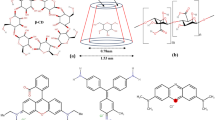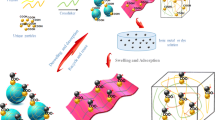Abstract
A novel magnetic chitosan hydrogel film, cross-linked with glyoxal (Fe3O4NPs/CS/glyoxal), has been synthesized and used as an easily reusable adsorbent for 80–90 % removal of toxic Cr(VI) from water. A pseudo-second-order kinetic (with correlation coefficient R 2 > 0.99) is observed at room temperature. Characterization of the absorbent is carried out by X-ray diffraction, scanning electron microscopy, and Fourier transform infrared spectroscopy. The adsorption isotherm is well fitted in the Langmuir equation at different temperatures [R 2 > 0.99, and 0 < (Langmuir separation factor, R L) < 1]. So, our adsorbent, with the novelty of using glyoxal, and the ease of separation may be considered in Cr(VI) wastewater treatment technology.
Similar content being viewed by others
References
Hsu L.C., Wang S.L., Lin Y.C., Wang M.K., Chiang P.N., Liu J.C., Kuan W.H., Chen C.C., Tzou Y.M.: Cr(VI) removal on fungal biomass of Neurospora crassa: the importance of dissolved organic carbons derived from the biomass to Cr(VI) reduction. Environ. Sci. Technol. 44, 6202–6208 (2010)
Krishna P.G., Gladis J.M., Rambabu U., Rao T.P., Naidu G.R.K.: Preconcentrative separation of Chromium(VI) species from chromium(III) by coprecipitation of its ethyl xanthate complex onto naphthalene. Talanta 63, 541–546 (2004)
Ramos R.L., Martinez A.J., Coronado R.M.G.: Adsorption of chromium(VI) from aqueous solutions on activated carbon. Water Sci. Technol. 30, 191–197 (1994)
Basha S., Murthy Z.V.P., Jha B.: Biosorption of hexavalent chromium by chemically modified seaweed, Cystoseira indica. Chem. Eng. J. 137, 480–488 (2008)
Xu Y., Zhao D.: Reductive immobilization of chromate in water and soil using stabilized iron nanoparticles. Water Res. 41, 2101–2108 (2007)
Monser L., Adhoum N.: Modified activated carbon for the removal of copper, zinc, chromium and cyanide from wastewater. Sep. Purif. Technol. 26, 137–146 (2002)
Kongsricharoern N., Polprasert C.: Chromium removal by a bipolar electro-chemical precipitation process. Water Sci. Technol. 34, 109–116 (1996)
Hafez A., El-Mariharawy S.: Design and performance of the two-stage/two-pass RO membrane system for chromium removal from tannery wastewater. Part 3. Desalination 165, 141–151 (2004)
Modrzejewska Z., Kaminski W.: Separation of Cr(VI) on chitosan membranes. Ind. Eng. Chem. Res. 38, 4946–4950 (1999)
Rengaraj S., Joo C.K., Kim Y., Yi J.: Kinetics of removal of chromium from water and electronic process wastewater by ion exchange resins: 1200H, 1500H and IRN97H. J. Hazard. Mater. 102, 257–275 (2003)
Rengaraj S., Yeon K.H., Moon S.H.: Removal of chromium from water and wastewater by ion exchange resins. J. Hazard. Mater. 87, 273–287 (2001)
Zhang D., Wei S., Kaila C., Su X., Wu J., Karki A.B., Young D.P., Guo Z.: Carbon-stabilized iron nanoparticles for environmental remediation. Nanoscale 2, 917–919 (2010)
Mohan D., Singh K.P., Singh V.K.: Removal of hexavalent chromium from aqueous solution using low-cost activated carbons derived from agricultural waste materials and activated carbon fabric cloth. Ind. Eng. Chem. Res. 44, 1027–1042 (2005)
Karthikeyan T., Rajgopal S., Miranda L.R.: Chromium(VI) adsorption from aqueous solution by Hevea Brasilinesis sawdust activated carbon. J. Hazard. Mater. 124, 192–199 (2005)
Oliveira E.A., Montanher S.F., Andrade A.D., Nobrega J.A., Rollemberg M.C.: Equilibrium studies for the sorption of chromium and nickel from aqueous solutions using raw rice bran. Process Biochem. 40, 3485–3490 (2005)
Singh K.K., Rastogi R., Hasan S.H.: Removal of Cr(VI) from wastewater using rice bran. J. Colloid Interface Sci. 290, 61–68 (2005)
Baral S.S., Das S.N., Rath P.: Hexavalent chromium removal from aqueous solution by adsorption on treated sawdust. Biochem. Eng. J. 31, 216–222 (2006)
Debnath S., Ghosh U.C.: Kinetics, isotherm and thermodynamics for Cr(III) and Cr(VI) adsorption from aqueous solutions by crystalline hydrous titanium oxide. J. Chem. Thermodyn. 40, 67–77 (2008)
Bhaumik M., Maity A., Srinivasu V.V., Onyango M.S.: Removal of hexavalent chromium from aqueous solution using polypyrrole–polyaniline nanofibers. Chem. Eng. J. 181–182, 323–333 (2012)
Bhaumik M., Setshedi K., Maity A., Onyango M.S.: Chromium(VI) removal from water using fixed bed column of polypyrrole/Fe3O4 nanocomposite. Sep. Purif. Technol. 110, 11–19 (2013)
Altaş L., Kiliç A., Koçyiğit H., Işik M.: Adsorption of Cr(VI) on ureolytic mixed culture from biocatalytic calcification reactor. Colloids Surf. B 86, 404–408 (2011)
Gupta V.K., Rastogi A., Nayak A.: Adsorption studies on the removal of hexavalent chromium from aqueous solution using a low cost fertilizer industry waste material. J. Colloid Interface Sci. 342, 135–141 (2010)
Sankararamakrishnan N., Dixit A., Iyengar L., Sanghi R.: Removal of hexavalent chromium using a novel cross linked xanthated chitosan. Bioresour. Technol. 97, 2377–2382 (2006)
Kandile N.G., Nasr A.S.: Environment friendly modified chitosan hydrogels as a matrix for adsorption of metal ions, synthesis and characterization. Carbohydr. Polym. 78, 753–759 (2009)
Wang L., Wang A.: Adsorption properties of Congo Red from aqueous solution onto N,O-carboxymethyl-chitosan. Bioresour. Technol. 99, 1403–1408 (2008)
Ruiz M., Sastre A.M., Guibal E.: Palladium sorption on glutaraldehyde-crosslinked chitosan. React. Funct. Polym. 45, 155–173 (2000)
Ngah W.S.W., Endud C.S., Mayanar R.: Removal of copper(II) ions from aqueous solution onto chitosan and cross-linking chitosan beads. React. Funct. Polym. 20, 181–190 (2002)
Thinh N.N., Hanh P.T.B., Ha L.T.T., Anh L.N., Hoang T.V., Hoang V.D., Dang L.H., Khoi N.V., Lam T.D.: Magnetic chitosan nanoparticles for removal of Cr(VI) from aqueous solution. Mater. Sci. Eng. C 33, 1214–1218 (2013)
Li N., Bai R.: Development of chitosan-based granular adsorbents for enhanced and selective adsorption performance in heavy metal removal. Water Sci. Technol. 54, 103–113 (2006)
Shawky H.A.: Synthesis of ion-imprinting chitosan/PVA crosslinked membrane for selective removal of Ag(I). J. Appl. Polym. Sci. 114, 2608–2615 (2009)
Martinez L., Agnely F., Leclerc B., Siepmann J., Cotte M., Geiger S., Couarraze G.: Cross-linking of chitosan and chitosan poly(ethylene oxide) beads: a theoretical treatment. Eur. J. Pharm. Biopharm. 67, 339–348 (2007)
Monier M.: Adsorption of Hg2+, Cu2+ and Zn2+ ions from aqueous solution using formaldehyde cross-linked modified chitosan-thioglyceraldehyde schiff’s base. Int. J. Biol. Macromol. 50, 773–781 (2012)
Hritcu D., Popa M.I., Popa N., Badescu V., Balan V.: Preparation and characterization of magnetic chitosan nanospheres. Turk. J. Chem. 33, 785–796 (2009)
Pohanish, R. P., Greene, Stanley A.: Wiley Guide to Chemical Incompatibilities. Wiley, New Jersey (2009)
Pohanish R. P.: Sittig’s Handbook of Toxic and Hazardous Chemicals and Carcinogens. William Andrew, Waltham, MA (2011)
Ayres J.G., Harrison R.M., Nichols G.L., Maynard R.L.: Environmental Medicine. CRC Press, London (2010)
Lawley R., Curtis L., Davis J.: Food Safety Hazard Guidebook. Royal Society of Chemistry, New York (2012)
Robertson G.L.: Food Packaging: Principles and Practice. CRC Press, Florida (2012)
Chen D., Li W., Wu Y., Zhu Q., Lu Z., Du G.: Preparation and characterization of chitosan/montmorillonite magnetic microspheres and its application for the removal of Cr(VI). Chem. Eng. J. 221, 8–15 (2013)
Hu X.J., Wang J.S., Liu Y.G., Li X., Zeng G.M., Bao Z.L., Zeng X.X., Chen A.W., Long F.: Adsorption of chromium(VI) by ethylenediamine-modified cross-linked magnetic chitosan resin: Isotherms, kinetics and thermodynamics. J. Hazard. Mater. 185, 306–314 (2011)
Mohammadi R., Kassaee M.Z.: Sulfochitosan encapsulated nano-Fe3O4 as an efficient and reusable magnetic catalyst for green synthesis of 2-amino-4H-chromen-4-yl phosphonates. J. Mol. Catal. A: Chem. 380, 152–158 (2013)
Pavia D.L., Lampman G.M., Kriz G.S.: Introduction to Organic laboratory techniques: A Microscale Approach. The Thomson Corporation, Belmont, CA (2007)
Pine S.H., Hendrickson J.B., Cram D.J., Hammono G.S.: Organic Chemistry. McGraw-Hill, New York (1980)
Yao K., Li J., Yao F., Yin Y.: Chitosan-Based Hydrogels: Functions and Applications. CRC Press, USA (2012)
Chuang Y.C., Chen D.H.: Preparation and adsorption properties of monodisperse chitosan-bound Fe3O4 magnetic nanoparticles for removal of Cu(II) ions. J. Colloid Interface Sci. 238, 446–451 (2005)
Li G.Y., Jiang Y., Huang K., Ding P., Chen J.: Preparation and properties of magnetic Fe3O4-chitosan nanoparticles. J. Alloys Compd. 466, 451–456 (2008)
Zhi J., Wang Y., Lu Y., Ma J., Luo G.: In situ preparation of magnetic chitosan/Fe3O4 composite nanoparticles in tiny pools of water-in-oil microemulsion. React. Funct. Polym. 66, 1552–1558 (2006)
Nakano Y., Bin Y., Bando M., Nakashima T., Okuno T., Kurosu H., Matsuo M.: Structure and mechanical properties of chitosan/poly(vinyl alcohol) blend films. Macromol. Symp. 258, 63–81 (2007)
Benguella B., Benaissa H.: Cadmium removal from aqueous solutions by chitin: Kinetic and equilibrium studies. Water Res. 36, 2463–2474 (2002)
Alzahrani E.: Fabrication and characterisation of chitosan-magnetic nanoparticles and its application for protein extraction. Int. J. Adv. Sci. Res. 4, 755–766 (2014)
Weckhuysen B.M., Wachs I.E., Schoonheydt R.A.: Surface chemistry and spectroscopy of chromium in inorganic oxides. Chem. Rev. 96, 3327–3349 (1996)
Bayramoglu G., Celik G., Yılmaz M., Arica M.Y.: Modification of surface properties of Lentinus sajor-caju mycelia by physical and chemical methods: Evaluation of their Cr6+ removal efficiencies from aqueous medium. J. Hazard. Mater. 119, 219–229 (2005)
Wu F.C., Tseng R.L., Juang R.S.: A review and experimental verification of using chitosan and its derivatives as adsorbents for selected heavy metals. J. Environ. Manag. 91, 798–806 (2010)
Chang Y.C., Chang S.W., Chen D.H.: Magnetic chitosan nanoparticles: Studies on chitosan binding and adsorption of Co(II) ions. React. Funct. Polym. 66, 335–341 (2006)
Zhang H., Tang Y., Cai D., Liu X., Wang X., Huang Q., Yu Z.: Hexavalent chromium removal from aqueous solution by algal bloom residue derived activated carbon: Equilibrium and kinetic studies. J. Hazard. Mater. 181, 801–808 (2010)
Chu X.Z., Zhao Y.J., Kan Y.H., Zhang W.G., Zhou S.Y., Zhou Y.P., Zhou L.: Dynamic experiments and model of hydrogen and deuterium separation with micropore molecular sieve Y at 77K. Chem. Eng. J. 152, 428–433 (2009)
Luo C., Wei R., Guo D., Zhang S., Yan S.: Adsorption behavior of MnO2 functionalized multi-walled carbon nanotubes for the removal of cadmium from aqueous solutions. Chem. Eng. J. 225, 406–415 (2013)
Ho Y.S.: Citation review of Lagergren kinetic rate equation on adsorption reactions. Scientometrics 59, 171–177 (2004)
Shukla S.R., Pai R.S., Shendarkar A.D.: Adsorption of Ni(II), Zn(II) and Fe(II) on modified coir fibres. Sep. Purif. Technol. 47, 141–147 (2006)
Badruddoza A.Z.M., Shawon Z.B.Z., Daniel T.W.J, Hidajat K., Uddin M.S.: Fe3O4/cyclodextrin polymer nanocomposites for selective heavy metals removal from industrial wastewater. Carbohydr. Polym. 91, 322–332 (2013)
Zuo X.J, Balasubramanian R.: Evaluation of a novel chitosan polymer-based adsorbent for the removal of chromium(III) in aqueous solutions. Carbohydr. Polym. 92, 2181–2186 (2013)
Author information
Authors and Affiliations
Corresponding author
Rights and permissions
About this article
Cite this article
Mirabedini, M., Kassaee, M.Z. & Poorsadeghi, S. Novel Magnetic Chitosan Hydrogel Film, Cross-Linked with Glyoxal as an Efficient Adsorbent for Removal of Toxic Cr(VI) from Water. Arab J Sci Eng 42, 115–124 (2017). https://doi.org/10.1007/s13369-016-2062-1
Received:
Accepted:
Published:
Issue Date:
DOI: https://doi.org/10.1007/s13369-016-2062-1




